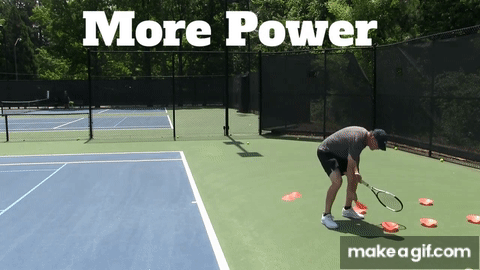I need more details on what your coach means by "come around your FH".
- We rotate around front (non-dominant) leg/hip on weight transfer FHs (square stance in video below)
- we rotate around back (dominant) leg/hip on open stance FHs
- the anchoring over one leg (on occasion both) is key in power in stroke ... if your anchor moves to soon you lose power
- things happen in follow through after contact which is just a natural result of actions before contact ... after the fact, arm and racquet follow through ... back leg might come around ... just follow through
So how would coach frame the "come around" for the two fh types?
In Fed video below ... he slighly drags back leg forward on square (weight transfer) FHs.
Watch open stance FHs starting @01:00 ... after contact he does get off the ground and feet land after rotation. I actually hadn't noticed this before ... but to me this is just like a natural arm follow through ... least stress for Fed to allow hop and rotate. If you watch Djokovic hit some open stance FHs in video right after Fed, in those examples he does not rotate right leg/foot forward.
I think max power from fh comes when shoulders do not rotate through contact. Fed is a perfect example, shoulder turn pauses, arm continues forward, then more shoulder/torso rotation after contact in follow through. I'm curious if your coach is promoting rotating torso/shoulders at contact.
]
BBP I am not sure I can explain the more technical details, but what the coach is trying to teach is this (like you see in the video fro Brian Dubal):
- Have a forward movement with your body in your forehand (and backhand too) to get more power and a more dynamic approach - (most RC players just stand still, and arm the ball even with backweight)
- Move move move, smalls adjustment steps all the time, dance around the ball.
- Lower your body position, be closer to the ground to better push off with your legs.
- Be fluent and relaxed in your strokes.
He is trying to teach us to use our whole body much more in our strokes (not just the forehand), be more dynamic, move better (footwork plays a big part in his training).
We also work a lot on open stands in both FH and BH, when pulled wide - proper footwork is very important here.
I am not saying this is the only way, but this is the style he teaches. I can fore sure see the effect in my own groundstrokes, now suddenly I got what is called easy power where I can hit a heavy ball without effort. I think is is kind of when you hit against these skinny junior players (without much muscle mass) and they can hit with a lot of power on the ball, they can only do this if they use their whole body and not just the arm.
Hope this answers some of your questions.
Cheers, Toby




